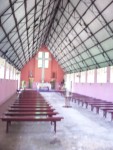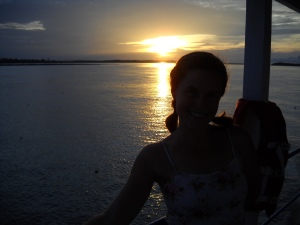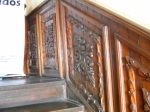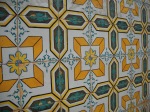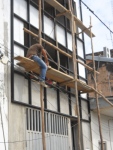January 7, 2013
Yanashi
The community of Yanashi (approximately 3000 people) faces the river with a long sidewalk that runs from one end to the other. In the center is a park area that is landscaped with well manicured lawns and pretty flower beds. A woman is working in a bed and a man wearing safety gear uses a weed eater to cut grass. We visit the church, which is simple and beautiful and meet Sister Mary of the Snows, an Ursulane Nun originally from Quebec but obviously at home in Yanashi as she has lived here for 43 years. She is chatty, and talks with Devon about the flood last year, the missionary, gardens, and the recent emergence of young leaders in Yanashi, among many other things.
We next visit the school, which has been built by the Catholic Church. The school serves 600 children from the region, some from Yanashi and some from the neighboring communities. We talk with Mario Guimack Chino, the “Sub-Director” who has been teaching here for 29 years, and he is eager to tell us about his school. There is primary and secondary education here, a staff of 34 (25 teachers), and they are expanding with a new school building and when funds allow, a dormitory to serve a growing population. Tuition is expected, and Yanashi locals pay 25 soles per year; those from outside the community pay 30 soles. Uniform and school supplies are extra. The school has a generator that is used for administrative work. Two small solar panels stand in the courtyard. We are told that they work well but the batteries after 3-4 years have stopped holding a charge. Science and environmental education are included in curriculum and they do focus on the social impacts of environmental issues, Mario tells us. Approximately 15% of students go on to study at University in Iquitos, and 20% go into technical school. Young leaders are emerging in Yanashi, Mario says, because they are educated and empowered to question the status quo. There was a time when only the elders were leaders. Times are changing in Yanashi. The population has doubled in the past 10 years. Internet is expected by 2014.
Mario also tells us about a water system that was installed by “the Italians” about seven years ago, with intent to bring potable water to Yanashi households. The system includes water towers and other infrastructure, but has never worked.
Trade trip to Comandancia
After our trip to Yanashi, we return to the field station for lunch and then some free time before one trip back to Comandancia for trading. Some our our team take siestas, some go kayaking up the river, and I swim. It is my last chance to swim in the Rio Orosa, tributary to the great Amazon, and it feels damn good.
At 4:00 we head to Comandancia where they are expecting us at their community center. The building is open air, on stilts, and we all fear the floor will not hold our weight. But the community is ready for us with crafts they have made for trading laid out on the floor all around the room. There are woven jute bags and jewelry decorated with seeds, shells, and fish bones. There are wooden carvings and paddles. Everyone is there and the children are especially excited to see Shauna and Chad, who shower them with more gifts. I trade t-shirts for a bag and bracelet featuring a large piece of beetle carapace. To the children I give crayons and matchbox cars, which are a hit. This event (and it is an event), is somehow heartbreaking to me. I can’t really explain why, but perhaps I am just overwhelmed by how simple and sweet the people here are. It is a big deal that we are here to trade for goods they’ve made. And I am impressed by how much time and effort they’ve put into making these crafts to trade and depressed by the fact that I am trading a gently used t-shirt for something that is clearly much more special. I make note that they are pleased with the clothing, but what they really want are D batteries, children’s clothing, and cash.
That evening, we enjoy our last meal at Madre Selva and celebrate with a screening of Anaconda dubbed in Spanish.
-

-

-

-

-
Comandancia children say goodbye. (school house in background)
-

-
drying out
-

-

-

-

-

-

-
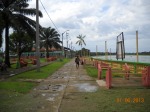
-

-

-

-

-

-

-

-

-
